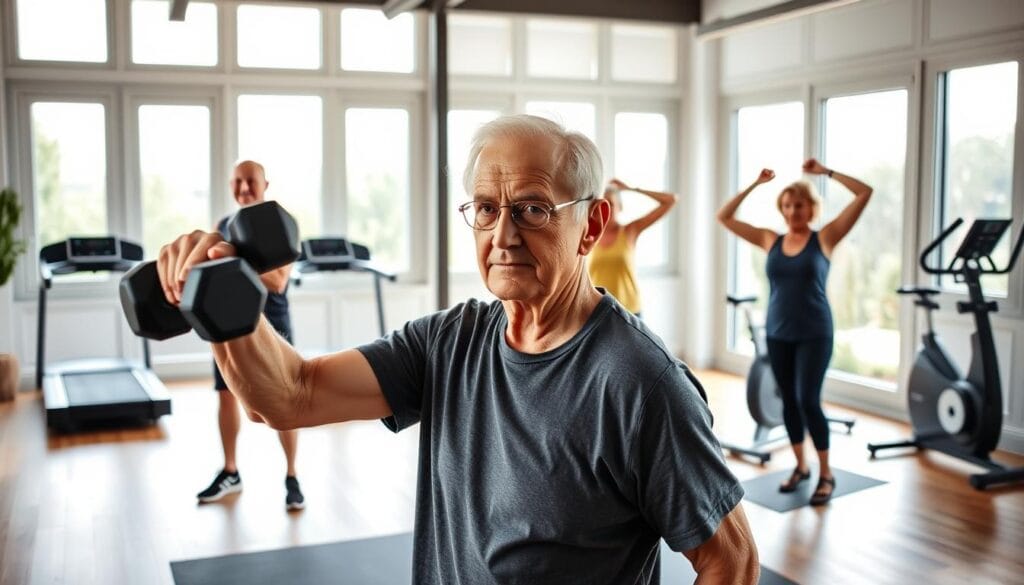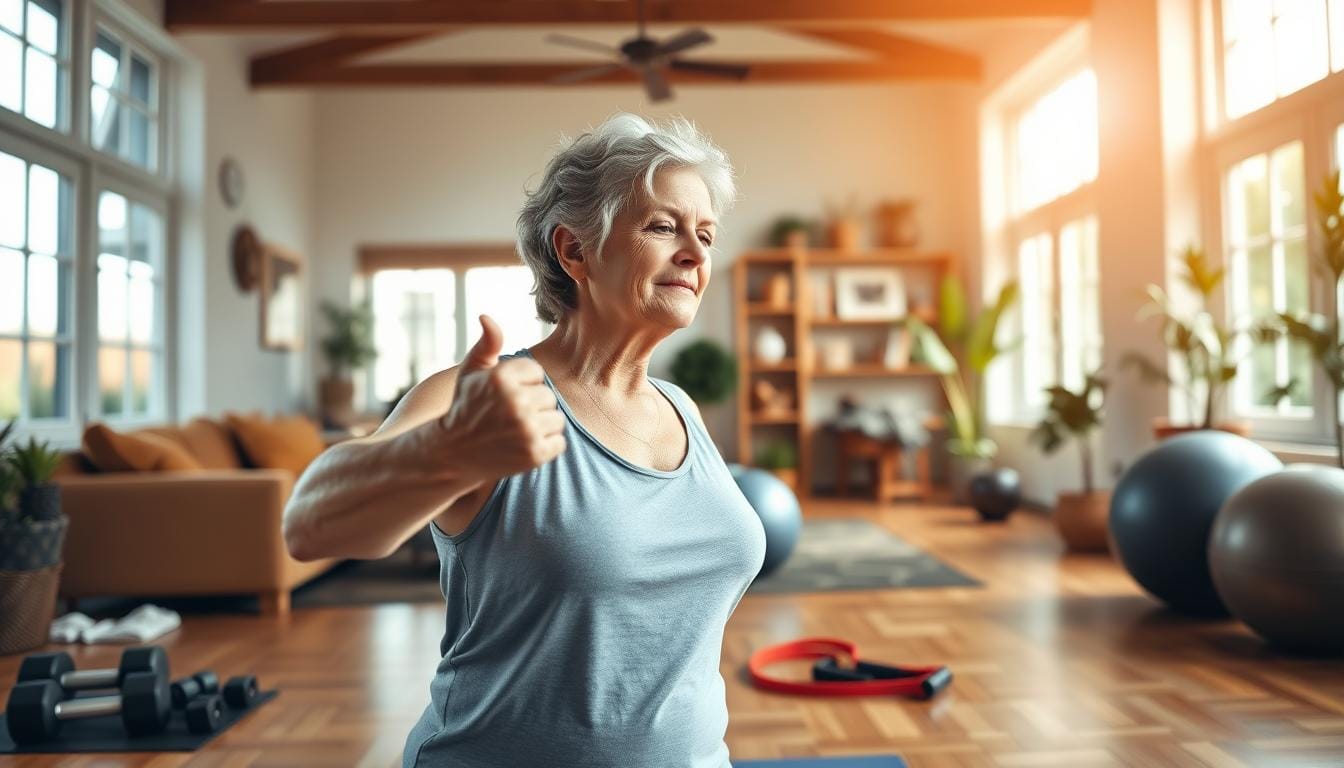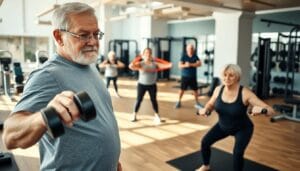Staying active is essential for maintaining independence and overall health. For many, the idea of joining a gym can feel overwhelming or impractical. Fortunately, simple, effective routines can be done in the comfort of your own space. Physical therapist Ann Phelps emphasizes the importance of daily foundational movements to support functional fitness.
Programs like SilverSneakers offer free online classes, making it easier to stay consistent. Regular exercise not only boosts energy but also reduces the risk of falls, a common concern as we age. The American Heart Association recommends at least 150 minutes of moderate activity weekly to maintain cardiovascular health.
This article explores key categories of strength training and flexibility exercises designed for safety and accessibility. Whether you’re new to fitness or looking to refine your routine, these tips will help you stay strong and confident.
Key Takeaways
- Daily movement supports independence and overall well-being.
- Physical therapist Ann Phelps recommends foundational exercises.
- SilverSneakers provides free online classes for guided routines.
- Regular activity reduces fall risks and improves energy levels.
- The American Heart Association suggests 150 minutes of weekly activity.
- Safety-first approach ensures effective and injury-free routines.
- Home-based exercises are convenient and accessible for all fitness levels.
Why Home Workouts Are Essential for Seniors
Maintaining physical activity is a cornerstone of healthy aging. For older adults, regular exercise reduces the risk of heart disease by 23% and improves blood sugar regulation by 18-34% in those with diabetes. These benefits highlight the importance of staying active to support overall health.
According to the CDC, falls are the leading cause of injury among older adults, with one in four experiencing a fall each year. Weight-bearing exercises can increase bone density by 15%, reducing the risk of fractures. Additionally, activities like walking and cycling promote joint lubrication, enhancing mobility and comfort.
Exercise also offers psychological advantages. Studies show a 30% reduction in depression symptoms among active individuals. The Arthritis Foundation emphasizes that even low-impact activities like walking can improve mood and reduce pain. Harvard research further supports the benefits of cycling, which is gentle on joints while boosting cardiovascular health.
Preventive fitness can lead to significant Medicare cost savings by reducing the need for medical interventions. For those with limited mobility, home-based routines are often more effective than gym sessions, as they can be tailored to individual needs and abilities. This approach ensures safety while improving strength and balance.
In summary, staying active at home provides a practical solution for maintaining health and independence. It addresses both physical and mental well-being, making it an essential part of a healthy lifestyle for older adults.
Getting Started: Safety Tips for Senior Home Workouts
Safety is the foundation of any successful exercise program, especially for older adults. Before beginning, consulting a doctor is essential, particularly for those with conditions like osteoporosis or hypertension. A medical evaluation ensures that the chosen activities align with individual health needs.
Proper equipment enhances safety and effectiveness. A yoga mat provides cushioning, while 2-5lb dumbbells and resistance bands add versatility. Non-slip footwear and a heart rate monitor are also recommended to prevent accidents and track intensity.
When using a sturdy chair, ensure it has the right armrest height and seat depth for support. This helps maintain proper posture and reduces strain. For standing exercises, keep feet hip-width apart and bend knees slightly to improve balance.
Warming up is crucial. Spend 5-7 minutes on dynamic stretches to prepare muscles and joints. Hydration is equally important; drink 8oz of water every 20 minutes during activity to stay energized and prevent dehydration.
For those with arthritis, modifications like gentler movements or shorter durations can make exercises more comfortable. Always listen to your body and stop if you feel pain or discomfort.
- Consult a doctor before starting any new routine.
- Use a sturdy chair with proper support for seated exercises.
- Wear non-slip footwear and use a heart rate monitor.
- Warm up with dynamic stretches for 5-7 minutes.
- Stay hydrated by drinking 8oz of water every 20 minutes.
- Modify exercises for arthritis or other limitations.
Balance Exercises to Prevent Falls
Improving stability is key to reducing fall risks and enhancing mobility. According to the CDC, falls are the leading cause of injury among older adults, but regular balance exercises can reduce this risk by 27%. These routines focus on strengthening the legs and improving coordination, which are essential for staying steady.
One effective exercise is foot taps. Start by standing tall with your feet hip-width apart. Lift one foot and tap it forward, then to the side, and finally behind you. Repeat this pattern 15-20 times per leg. This movement helps build strength and stability in the lower body.
Single-leg raises are another great option. Stand tall and lift one leg slightly off the ground, holding for 10 seconds. Perform 5 reps on each side. This exercise challenges your balance while strengthening the muscles that support it.
For vestibular training, try body circles. Stand tall with your feet together and slowly move your upper body in a circular motion for 30 seconds. This exercise improves coordination and helps prevent dizziness, a common cause of falls.
Seated-to-standing variations are ideal for those who need extra support. Sit in a sturdy chair and practice standing up without using your hands. This movement strengthens the legs and improves overall stability.
Finally, the tandem walk is a simple yet effective progression. Place one foot directly in front of the other and take 20-25 steps daily. This exercise enhances coordination and helps improve balance over time.
Incorporating these exercises into your routine can significantly reduce fall risks and boost confidence in daily activities. Remember to stand tall and focus on proper form to maximize benefits.
Strength Training for Seniors
Strength training offers a practical way to enhance physical resilience and daily function. It focuses on building muscle, improving posture, and reducing the risk of injuries. These exercises are designed to be safe and effective, even for those with limited mobility.

One foundational exercise is the sit-to-stand movement. Perform 3 sets of 10 reps daily to strengthen the legs and improve stability. Wall pushups are another excellent option; maintain a 3ft distance from the wall and complete 8-12 reps per session to target the arms and shoulders.
For core activation, try the pelvic tilt technique. Lie on your back with knees bent, flatten your lower back against the floor, and hold for 5 seconds. Repeat 10-15 times to engage the abdominal muscles.
Knee extensions are ideal for strengthening the legs. Sit in a chair and straighten one leg at a time, holding for 3 seconds. Complete 10-15 reps per leg to enhance mobility and support joint health.
When performing overhead presses, use light weights and ensure proper form to avoid strain on the shoulders. Keep your core engaged and lift right to maintain alignment.
Dumbbell rows are effective for building back strength. Hold a dumbbell in one hand, place the opposite knee on a bench, and pull the weight toward your torso. Perform 10-12 reps per side.
Chair-assisted squats are a safe progression for lower body strength. Stand in front of a chair, lower yourself until you lightly touch the seat, and return to standing. Aim for 8-10 reps to build leg power.
- Strengthen the legs with sit-to-stand exercises and knee extensions.
- Target the arms and shoulders with wall pushups and overhead presses.
- Enhance back strength using dumbbell row variations.
- Improve core stability with the pelvic tilt technique.
- Progress safely with chair-assisted squats for lower body power.
Flexibility and Stretching Routines
Enhancing flexibility is a vital component of maintaining mobility and comfort. Stretching routines can improve range of motion, reduce stiffness, and support joint health. These exercises are designed to be safe and effective for all fitness levels.
One foundational stretch is the seated hamstring stretch. Sit on the edge of a chair, extend one leg forward, and reach toward your toes. Hold for 30 seconds to gently lengthen the muscles.
For the back, try the thoracic spine rotation. Sit tall, place your hands behind your head, and rotate your upper body to one side. Hold for 3 seconds and repeat 8-12 times per side.
Ankle circles are excellent for improving mobility in the lower back and legs. Lift one foot and rotate it in a circular motion 5-7 times in each direction. This exercise enhances joint flexibility and reduces stiffness.
The “thread the needle” yoga pose is a gentle adaptation for the shoulders and hips. Start on all fours, slide one arm under the opposite side, and rest your shoulder on the floor. Hold for 15-20 seconds to release tension.
PNF stretching techniques are effective for the hips. Contract the muscle for 5 seconds, then relax and stretch it further. This method improves flexibility and range of motion.
Wrist and finger flexion exercises are also beneficial. Extend your arm, open your hand, and gently pull back your fingers. Hold for 10 seconds to improve grip strength and reduce stiffness.
- Perform seated hamstring stretches to lengthen muscles.
- Use thoracic spine rotations to improve back mobility.
- Rotate ankles in circles to enhance joint flexibility.
- Try the “thread the needle” pose for shoulders and hips.
- Incorporate PNF stretching for deeper muscle release.
- Practice wrist and finger flexion to reduce stiffness.
Cardio Exercises for a Healthy Heart
Cardiovascular health is a cornerstone of overall well-being, especially as we age. Regular exercise strengthens the heart, improves circulation, and boosts energy levels. Simple activities like walking for 10-20 minutes daily can make a significant difference.
For those seeking variety, rowing machines engage 86% of major muscle groups, providing a full-body workout. Cycling and water aerobics are excellent alternatives; cycling burns approximately 400 calories per hour, while water aerobics offers low-impact resistance training.
Step count goals are another effective way to stay active. Aim for 2,500-5,000 steps daily to maintain cardiovascular fitness. Seated marching is a great option for those with limited mobility. Lift each knee 10 times per leg while seated to improve circulation and body strength.
Stationary bikes are versatile tools for cardio. Adjust resistance settings to match your fitness level, starting with light resistance and gradually increasing as endurance improves. Interval walking is another technique; alternate 1 minute of brisk walking with 2 minutes of slower pacing to maximize benefits.
Monitoring your pulse rate during exercise ensures you stay within a safe range. Aim for 50-70% of your maximum heart rate during moderate activity. This approach keeps your heart healthy while reducing the risk of overexertion.
- Compare calorie burn: cycling vs. water aerobics.
- Set step count goals between 2,500-5,000 steps daily.
- Perform seated marching with 10 reps per leg.
- Adjust stationary bike resistance for optimal results.
- Practice interval walking (1 minute fast/2 slow).
- Monitor pulse rate to ensure safe exercise intensity.
Chair Exercises for Limited Mobility
Chair exercises provide a safe and effective way to stay active for individuals with limited mobility. These routines focus on improving strength, flexibility, and balance while reducing the risk of injury. Clinical studies show that chair yoga can reduce anxiety by 42%, making it a valuable addition to any fitness plan.
One foundational exercise is the seated leg press. Sit in a sturdy chair, place your hands on the armrests, and extend one leg forward. Perform 15-20 reps per leg to strengthen the lower body.
Arm circles are another effective progression. Sit tall, extend your arms to the sides, and rotate them forward and backward. This exercise improves shoulder mobility and upper body strength.
For core engagement, try seated torso rotations with a resistance band. Hold the band with both hands, rotate your upper body to one side, and return to the starting position. Repeat 10-12 times per side.
Modified jumping jacks are a seated adaptation for cardiovascular health. Sit tall, lift your palms overhead, and move your legs outward and inward. This exercise enhances coordination and endurance.
Seated rowing machine adaptations are ideal for building back strength. Use a resistance band, pull it toward your torso, and release. Perform 8-10 reps to improve posture and muscle tone.
Finally, the isometric hand press is a simple yet effective exercise. Press your hands together firmly for 5 seconds, then relax. Repeat 10-15 times to strengthen the upper body.
| Exercise | Reps/Sets | Benefits |
|---|---|---|
| Seated Leg Press | 15-20 reps/leg | Strengthens lower body |
| Arm Circles | 10-12 reps/side | Improves shoulder mobility |
| Seated Torso Rotation | 10-12 reps/side | Engages core muscles |
| Modified Jumping Jacks | 15-20 reps | Boosts cardiovascular health |
| Seated Rowing | 8-10 reps | Builds back strength |
| Isometric Hand Press | 10-15 reps | Strengthens upper body |
Conclusion: Stay Active, Stay Healthy
Consistency in physical activity leads to long-term health benefits. For older adults, regular exercise improves daily function and reduces the risk of chronic conditions. Studies show that 6-month adherence to a routine enhances performance in daily activities by 38%.
Tracking progress is essential. Use journals or apps to monitor improvements in strength and balance. Resources like AARP fitness guides and NIH guidelines provide valuable support for maintaining a safe and effective routine.
Always consult a physician before starting any new exercise program. This ensures activities align with individual needs and limitations. Over time, small, consistent efforts can lead to significant milestones, such as improved mobility and energy levels.
Take the first step today. Commit to a routine that supports your well-being and independence. Staying active is the key to a healthier, more fulfilling life.
FAQ
Why are balance exercises important for older adults?
Balance exercises help improve stability, reduce the risk of falls, and enhance coordination. They are crucial for maintaining independence and overall health.
What are some safe strength training exercises for seniors?
Safe options include chair squats, wall push-ups, and light dumbbell lifts. These exercises build muscle, improve bone density, and support daily activities.
How can chair exercises benefit those with limited mobility?
Chair exercises provide a low-impact way to improve strength, flexibility, and circulation. They are ideal for individuals who may have difficulty standing for long periods.
What should seniors focus on during flexibility routines?
Focus on gentle stretches for the neck, shoulders, hips, and legs. Stretching helps maintain range of motion, reduces stiffness, and prevents injury.
Are cardio exercises safe for older adults?
Yes, low-impact cardio like walking, marching in place, or seated leg lifts can improve heart health without straining joints. Always consult a doctor before starting a new routine.
How often should seniors exercise at home?
Aim for at least 150 minutes of moderate activity per week, spread over several days. Include a mix of balance, strength, flexibility, and cardio exercises.
What safety precautions should seniors take during home workouts?
Use a sturdy chair for support, wear non-slip shoes, and ensure the workout area is free of obstacles. Start slowly and stop if you feel pain or dizziness.
Can home workouts help prevent falls?
Yes, exercises that improve balance, leg strength, and coordination can significantly reduce the risk of falls. Regular practice is key to maintaining stability.





